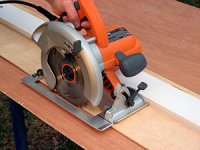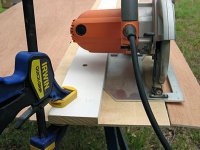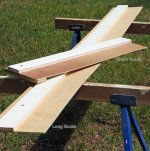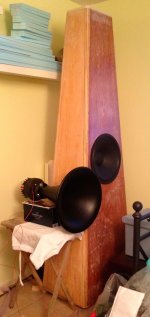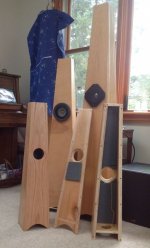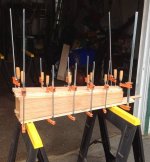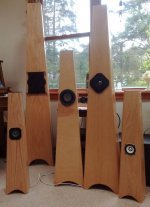Cutting long lengths straight with a skilsaw
I did see some remarks on making a jig for the table saw.
Howver you can easier work with a skillsaw: make a jig for it. Find a piece of material that has a straight edge and glue that on a piece of mdf or ply or what ever you have (I like MDF since it makes it nice smooth cut which makes it easy to line up).
Afterwards you run the skillsaw against this glued on guide.
Next time when you need to cut you just put this exact on the edge where you want to cut, clamp and cut away.
See pictures (taken from the web)
I did see some remarks on making a jig for the table saw.
Howver you can easier work with a skillsaw: make a jig for it. Find a piece of material that has a straight edge and glue that on a piece of mdf or ply or what ever you have (I like MDF since it makes it nice smooth cut which makes it easy to line up).
Afterwards you run the skillsaw against this glued on guide.
Next time when you need to cut you just put this exact on the edge where you want to cut, clamp and cut away.
See pictures (taken from the web)
Attachments
Lots of folks post these guides as easy methods to make a circular saw jig, and they are. However, there is one caveat that is never mentioned. It is harder to come up with that initial straight edge than people might think.
One cannot count on factory edges from the box store or lumberyard anymore. I suspect that many people start with a board from the store and don't check it.
One cannot count on factory edges from the box store or lumberyard anymore. I suspect that many people start with a board from the store and don't check it.
I did see some remarks on making a jig for the table saw.
Howver you can easier work with a skillsaw: make a jig for it. Find a piece of material that has a straight edge and glue that on a piece of mdf or ply or what ever you have (I like MDF since it makes it nice smooth cut which makes it easy to line up).
Afterwards you run the skillsaw against this glued on guide.
Next time when you need to cut you just put this exact on the edge where you want to cut, clamp and cut away.
See pictures (taken from the web)
One cannot count on factory edges from the box store or lumberyard anymore. I suspect that many people start with a board from the store and don't check it.
+1
Lots of folks post these guides as easy methods to make a circular saw jig, and they are. However, there is one caveat that is never mentioned. It is harder to come up with that initial straight edge than people might think.
One cannot count on factory edges from the box store or lumberyard anymore. I suspect that many people start with a board from the store and don't check it.
How true. But not impossible to straighten it yourself. Just another skillset that is at risk of being lost by the power tools crowd.
I have built Mets withFE108eSigma, F120A, and FE167e. All are very nice and I think you would be pleased with any of them.
That said, the F120A is my favorite--smoothest, best high freq and good enough low freq that I don't feel the need for a subwoofer; however, this driver doesn't sound good with direct coupled SS amps--the high freqs just die; with tubes it makes sweet, sweet music.
The FE108eS has great mids & highs, but the lows are limited enough that I like to use a sub with it.
The FE167e plays louder & sounds bigger with more authoritative bass. It gives up a bit of sound quality in the mids & highs, but is over-all quite pleasing.
I ran MJK MathCAD models of the FF125wk Met using the dimensions for the FE127e. It does work, but can be improved with a little tweaking. AFAIK there is no single, absolute solution for cabinet dimensions--there is always some wiggle room. The dimensions I settled on look OK to me, but someone else may find a slightly better solution.
I decreased the internal volume a bit, increased the length of the port, and increased Zd by 2". Changing Zd resulted in a bit less ripple in the SPL plot, but leaving Zd at 20" works OK--the ripple is then about what it is in the Mets I have built. So you can choose between higher driver placement and a little less ripple in the response.
Plotted response is for enclosure dimensions:
L= 48"
So= 2 x 2"
Sl= 7 x 5"
Zd= 22"
port: D=2", L=3"
I bought the worksheets and downloaded MathCad(15) 30 day trial. After getting myself familiar with the software I did some modelling.
When taking into account the room response then some other figures will show a lesser dip around the 200 - 300 hz range. In that case I came up with the port being 1.5" dia and a length of 1.75" while at the same time relocating the driver to 28" (!!!) from the top. I suspect the floorbounce and otehr room reflections will be responsible for this different behaviour since the graph in an "ideal" environment has hardly changed.
Well, I have cabinets built for my Faital 15 inch macro Metronomes, and they have been once again moved into my tiny listening room. They have been playing for about 4 weeks now, off and on (mostly on), and my Stereolab Tractrix horns arrived about 2 weeks ago, and were promptly attached to the pair of TAD 4002 drivers I've had laying around for a few years. I put a simple first order crossover on the woofers at 150Hz and a first order on the TADs that I settled on at about 1100 Hz. The huge 20 Ohm recommended series resistor for the TAD came in handy- in concert with a parallel 6 Ohm resistor, it brought the levels pretty well in line, but I'm working on my 18 Db high pass filter for the horns this weekend, as there is a dip in the response about 5-600Hz or so that needs to be addressed…
Overall, a really great sounding system for being so thrown together. The bass is more than powerful enough- I simply raised the base of the unfinished cabinet .75 inches from the floor to fiddle the response to my liking- the system signs off about 35Hz or so, but makes up for that with some of the fastest bass I have ever had in MY system. That, and the tremendous power handling makes for a system that can literally break windows with the kettle drum. I'm moving them to a larger room to make sure the system balance is good, then they are going to be finished in copper, and the height adjust mechanisms added to the horns, which are to be mounted on the sides of the cabinets.
I made my own resistors… The commercial units sound markedly inferior to about 14 feet of Nichrome V arranged in a hairpin bundle. The finished crossovers will mount to the back of the cabinets, wired completely with silk wrapped solid silver, which the Radian diaphragm equipped TAD seems to prefer over my commercial offerings. Haven't decided on my final caps- probably something beeswax and copper foil, though. There are a LOT to listen to…
Excuse the room… Getting ready to move things, and, you know, prototyping…
Overall, a really great sounding system for being so thrown together. The bass is more than powerful enough- I simply raised the base of the unfinished cabinet .75 inches from the floor to fiddle the response to my liking- the system signs off about 35Hz or so, but makes up for that with some of the fastest bass I have ever had in MY system. That, and the tremendous power handling makes for a system that can literally break windows with the kettle drum. I'm moving them to a larger room to make sure the system balance is good, then they are going to be finished in copper, and the height adjust mechanisms added to the horns, which are to be mounted on the sides of the cabinets.
I made my own resistors… The commercial units sound markedly inferior to about 14 feet of Nichrome V arranged in a hairpin bundle. The finished crossovers will mount to the back of the cabinets, wired completely with silk wrapped solid silver, which the Radian diaphragm equipped TAD seems to prefer over my commercial offerings. Haven't decided on my final caps- probably something beeswax and copper foil, though. There are a LOT to listen to…
Excuse the room… Getting ready to move things, and, you know, prototyping…
Attachments
Whats strange about the whole setup is- the horns currently sound best when they are down low like that. I'm making the height adjustable on the mounts.
I did "fudge" the port with Martin King's worksheets and there is a marked difference in reponse when the port is on the front or on the back. SO having it in the bottom is a good location (imho). When the port is on the front then raising the port up from the floor about 10" (from memory) and having the driver slightly below centre has best results when taking room response into account. But it just does not look the part with a port visible.
I am only able to work about an hour a day on them but they are coming along slowly but steadily. Bought some tiles this weekend and painted the edges (they are only glazed on the top).
One design decision I made was to "lean" them back about 5/16" at the top to minimise the risk of the enclosures leaning forwards due to the weight of the driver. Although it does not sound like a lot it is rather noticeable when positioned on the tiled kitchen floor and frankly I like the looks, especially considering that these will be placed close to the wall.
Wife never made remarks on the builds in the past but this time I got favourable feedback. Similarly daughter had complementary remarks on the shape. We'll wait until they are finished and have been run in for final feedback.
Completed these yesterday and the drivers (FF125WK) have only a few hours on them but they compare very favourably to some Monitor Audio Studio 12 that I have. Very, very impressed by the results, it is missing out to the MA in the highs but for the rest I prefer the metronomes.
What is the best full range ~~ 5" driver - this design deserves the best driver that can be found.
What is the best full range ~~ 5" driver - this design deserves the best driver that can be found.
Update: Metronome & FF125WK
Since firing these up on Thursday afternoon (it is now Sunday midday) I have been "running in" the drivers - gradually increasing volume and most of yesterday running at near or slighly visibly exceeding xMax limits on drum peaks.
Bass has come up considerably and treble has changed too. These belong to the best "bang for the buck" and perhaps I might even contemplate that these are the most listenable speakers that have gone through my place over the past 40 years.
And there have been quite a number of them, all of them (bar two pairs) gone. A Monitor Audio Studio 12 and a clone of the LS3/5A (the Kef constructor series which I preferred over the LS3/5A and the LS5/12) are the only two pairs that have survived the flow of equipment.
If it is any indication (the drivers are in different boxes) the FF125WK are more pleasant to my ears than the FE166En; I have been very impressed by the FF since starting to listen to them earlier this week.
Yesterday morning I was still contemplating: "I need some more bass output, I need to have this built with the FF165WK / FE168ES Sigma", now I think "bass is sufficient, I do not want a larger metronome - this is good enough".
I am listening to normal stereo, not HT, and do not listen to "real life" levels with window pane shattering bass etc.... They go loud enough for my requirements to the extend that I do turn the volume down after listening at a level where the driver visibly looks to be nearing maximum excursion on bass peaks. This is in a family room/open kitchen 8 meters x 4.5 meters and being seated about 3 or 4 meters away from the metronomes.
Hope this information helps someone making a decision to go one way or another. I like them and they are set to stay.
I also suspect this will be a first: I am actually contemplating a second pair with smaller drivers for use elsewhere in the home and am considering either the FE108e Sigma or the FF105WK.
Completed these yesterday and the drivers (FF125WK) have only a few hours on them but they compare very favourably to some Monitor Audio Studio 12 that I have. Very, very impressed by the results, it is missing out to the MA in the highs but for the rest I prefer the metronomes.
What is the best full range ~~ 5" driver - this design deserves the best driver that can be found.
Since firing these up on Thursday afternoon (it is now Sunday midday) I have been "running in" the drivers - gradually increasing volume and most of yesterday running at near or slighly visibly exceeding xMax limits on drum peaks.
Bass has come up considerably and treble has changed too. These belong to the best "bang for the buck" and perhaps I might even contemplate that these are the most listenable speakers that have gone through my place over the past 40 years.
And there have been quite a number of them, all of them (bar two pairs) gone. A Monitor Audio Studio 12 and a clone of the LS3/5A (the Kef constructor series which I preferred over the LS3/5A and the LS5/12) are the only two pairs that have survived the flow of equipment.
If it is any indication (the drivers are in different boxes) the FF125WK are more pleasant to my ears than the FE166En; I have been very impressed by the FF since starting to listen to them earlier this week.
Yesterday morning I was still contemplating: "I need some more bass output, I need to have this built with the FF165WK / FE168ES Sigma", now I think "bass is sufficient, I do not want a larger metronome - this is good enough".
I am listening to normal stereo, not HT, and do not listen to "real life" levels with window pane shattering bass etc.... They go loud enough for my requirements to the extend that I do turn the volume down after listening at a level where the driver visibly looks to be nearing maximum excursion on bass peaks. This is in a family room/open kitchen 8 meters x 4.5 meters and being seated about 3 or 4 meters away from the metronomes.
Hope this information helps someone making a decision to go one way or another. I like them and they are set to stay.
I also suspect this will be a first: I am actually contemplating a second pair with smaller drivers for use elsewhere in the home and am considering either the FE108e Sigma or the FF105WK.
Last edited:
I also suspect this will be a first: I am actually contemplating a second pair with smaller drivers for use elsewhere in the home and am considering either the FE108e Sigma or the FF105WK.
Nah mate, Jim Shearer has built a few too - looks like Metronomes can be addictive!
Have you considered the CSS EL70 for the second pair? It's a nice 4" full range driver as many will testify.
Nah mate, Jim Shearer has built a few too - looks like Metronomes can be addictive!
I know Jim built three pairs but as fair as I understand it each later pair used bigger drivers. I was trying to emphasize that I wanted to go smaller.
Thanks for the heads up on the CSS EL70 heads up and also to Dave for confirming same driver.
These metronomes are addictive all-right. In the last day or so the bass extension has become impressive.
I am in the process of making a gainclone amp and am considering giving it partial current feedback so it starts to behave like a tube amplifier but without the distortion. Variable Amplifier Impedance (fig 2) and which will need some compensation at the driver (R and RC) to offset the rising impedances. (http://www.passdiy.com/pdf/cs-amps-speakers.pdf)
Last edited:
AmadeusMozart and I have been corresponding, so he knows very well I built three Mets, starting with the FE108eS, then the F120A, then the FE167e. The Met is the only design I have built more than once. I really like both the aesthetics and acoustic performance of the Met. It looked like the perfect style to explore the characteristics of different Fostex drivers.
While Mets are a bit more challenging to build than a monkey coffin, I think they sound better. And they seem pleasing to the women folk!
Cheers, Jim
While Mets are a bit more challenging to build than a monkey coffin, I think they sound better. And they seem pleasing to the women folk!
Cheers, Jim
FF85k Bipole Mini-Mets
Last year I made a test cabinet with 4 FF85k drivers borrowed from a pair of OBs and a pair of micro-Fonkens. One driver mounted on the top and one on each of three sides. The FF85k sounded great, as usual, but the sonic presentation wasn’t what I wanted.
I like the presentation of OBs and panel speakers which are dipoles, so this year, I thought I would try a bipole. After all, the only difference between a dipole and a bipole is phase, right? And the three pairs of Mets I have built previously all sound good, so a bipole Met has to be great!
Here are the parameters which yielded a good looking model in MJK’s MathCAD worksheets:
L= 28”
S(0)= 2.5” x 2”
S(L)= 5” x 4.5”
Z(d)= 14 +/- 2” (front & rear drivers off-set)
R(p)= 1.05”
L(p)= 3”
Z(p)= 25” (down firing port)
Note: I put the binding posts on the bottom beside the port, so they can be turned around to have the front facing driver either 18.75” or 14.75” from the bottom. My thought was that they would be used standing on top of a subwoofer (XO about 80 Hz).
Photo 1: partly assembled
Photo 2: final glue-up
Photo 3: finished! ‘family’ photo
In the third photo, from left to right:
-- mini-Met from the front;
-- FE167e Met;
-- FE108eSigma Met;
-- F120A Met;
-- mini-Met from the back.
So how do they sound? Good.
As expected, they are much like the MJK passive OB (from which two of the FF85k’s were extracted) in both sonic presentation and limitations. They need to be at least 3 feet from the wall, or else there are sonic issues: e.g. when I placed them only about 12” from the wall, there seemed to be a suck-out around 400 Hz, and they were, well, just sort of weird. They are way smaller than the OBs, and have usable response only down to 80 Hz, so they need a sub to help on the low end. And because they are playing full range, they are more limited than the OBs for spl, especially with complex orchestral music. Putting an XO on them, at say 120 Hz, and placing them on top of a woofer unit would be a significant improvement.
They have that property of extracting the ‘hall sound’ from a recording that I find attractive in OB and panel speakers--the very property that some folks love, while others run screaming from the room. Certainly not everyone’s cup of tea, but I find them very engaging.
Cheers, Jim
Last year I made a test cabinet with 4 FF85k drivers borrowed from a pair of OBs and a pair of micro-Fonkens. One driver mounted on the top and one on each of three sides. The FF85k sounded great, as usual, but the sonic presentation wasn’t what I wanted.
I like the presentation of OBs and panel speakers which are dipoles, so this year, I thought I would try a bipole. After all, the only difference between a dipole and a bipole is phase, right? And the three pairs of Mets I have built previously all sound good, so a bipole Met has to be great!
Here are the parameters which yielded a good looking model in MJK’s MathCAD worksheets:
L= 28”
S(0)= 2.5” x 2”
S(L)= 5” x 4.5”
Z(d)= 14 +/- 2” (front & rear drivers off-set)
R(p)= 1.05”
L(p)= 3”
Z(p)= 25” (down firing port)
Note: I put the binding posts on the bottom beside the port, so they can be turned around to have the front facing driver either 18.75” or 14.75” from the bottom. My thought was that they would be used standing on top of a subwoofer (XO about 80 Hz).
Photo 1: partly assembled
Photo 2: final glue-up
Photo 3: finished! ‘family’ photo
In the third photo, from left to right:
-- mini-Met from the front;
-- FE167e Met;
-- FE108eSigma Met;
-- F120A Met;
-- mini-Met from the back.
So how do they sound? Good.
As expected, they are much like the MJK passive OB (from which two of the FF85k’s were extracted) in both sonic presentation and limitations. They need to be at least 3 feet from the wall, or else there are sonic issues: e.g. when I placed them only about 12” from the wall, there seemed to be a suck-out around 400 Hz, and they were, well, just sort of weird. They are way smaller than the OBs, and have usable response only down to 80 Hz, so they need a sub to help on the low end. And because they are playing full range, they are more limited than the OBs for spl, especially with complex orchestral music. Putting an XO on them, at say 120 Hz, and placing them on top of a woofer unit would be a significant improvement.
They have that property of extracting the ‘hall sound’ from a recording that I find attractive in OB and panel speakers--the very property that some folks love, while others run screaming from the room. Certainly not everyone’s cup of tea, but I find them very engaging.
Cheers, Jim
Attachments
Just completed a test box with the FF105WK.
L = 42"
So = 1 7/16" x 2 3/16"
Sl = 4 1/4" x 6 1/4"
Zd = 22 1/2"
Rp = 3/4" (due to availability of standard pipe it is actually 0.7608")
Lp = 2 1/4"
Radd = 1.5 Ohm
Bass cutoff is approx 7 ~ 8 Hz higher than the FF125WK. Mid bass is a bit less pronounced but it can be due to still needing to run in (or damping material), voices are lovely and the 7 ~ 8 Khz "peak" is not noticeable (perhaps I am slightly going deaf at the high frequencies?)
I'm still tossing up which one I prefer - if anything for larger rooms I think I like the FF125WK for the bass that goes marginally lower but there is very little between the two.
I attempted to veneer them with jarrah but that failed - I will have to rebuild them and likely will use some solid timber instead.
As an experiment I placed the FF125WK facing the walls and the FF105WK facing the room with the backs against each other. Worked nicely and one idea I am working on is build a single enclosure which is internally divided in between the FF125WK and the FF105WK with each having their own tuning. I will need to lengthen FF105WK enclosure and shorten the FF125WK so the lengths come out the same and then fiddle with the divider to adjust the volumes.
L = 42"
So = 1 7/16" x 2 3/16"
Sl = 4 1/4" x 6 1/4"
Zd = 22 1/2"
Rp = 3/4" (due to availability of standard pipe it is actually 0.7608")
Lp = 2 1/4"
Radd = 1.5 Ohm
Bass cutoff is approx 7 ~ 8 Hz higher than the FF125WK. Mid bass is a bit less pronounced but it can be due to still needing to run in (or damping material), voices are lovely and the 7 ~ 8 Khz "peak" is not noticeable (perhaps I am slightly going deaf at the high frequencies?)
I'm still tossing up which one I prefer - if anything for larger rooms I think I like the FF125WK for the bass that goes marginally lower but there is very little between the two.
I attempted to veneer them with jarrah but that failed - I will have to rebuild them and likely will use some solid timber instead.
As an experiment I placed the FF125WK facing the walls and the FF105WK facing the room with the backs against each other. Worked nicely and one idea I am working on is build a single enclosure which is internally divided in between the FF125WK and the FF105WK with each having their own tuning. I will need to lengthen FF105WK enclosure and shorten the FF125WK so the lengths come out the same and then fiddle with the divider to adjust the volumes.
- Home
- Loudspeakers
- Full Range
- The Metronome
